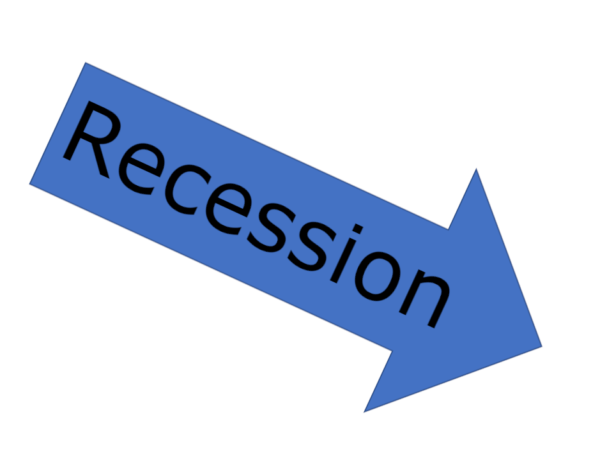[ad_1]
The debate about recession risk is pointless. We are already in a recession. Real GDP (gross domestic product) in the United States declined at an annual rate of 1.6% in the first quarter.
The Atlanta Fed Nowcast shows a 1.5% contraction in the second quarter. But the underlying figures are scarier. According to the Atlanta Fed, “the GDPNow model estimate for real GDP growth (seasonally adjusted annual rate) in the second quarter of 2022 is -1.5% on July 15, down from -1.2% on July 8”. That is an enormous negative change, -0.3% of GDP, in one week.
They go on to say that “the nowcast of second quarter real personal consumption expenditures growth and real gross private domestic investment growth decreased from 1.9% and -13.7%, respectively, to 1.5% and -13.8%, respectively”.
Investment is collapsing, consumption is barely kept alive and if we look at other components, imports are soaring while exports rise less than expected.
This is the backlash of massive stimulus packages. An artificial boost to GDP in one year from two trillion US dollars of excessive spending generated a non-structural rise in GDP that immediately leads to a contraction. However, the debt increase remains, and the structural problems are evident.
The labor market is only strong in headlines. In June, the number of long-term unemployed was unchanged at 1.3 million. This is 215,000 higher than in February 2020. Labor force participation rate was 62.2%, employment-population ratio 59.9%. Both remain below February 2020 levels (63.4% and 61.2%) according to the Bureau of Labor Statistics (BLS). Meanwhile, inflation eats any wage rise and real median wage increase is negative in 2022. Real average hourly earnings decreased 3.6 percent, seasonally adjusted, from June 2021 to June 2022, the BLS reports.
Negative real wage growth, weakening consumption, decade-low consumer confidence and collapsing investment means we are already in recession and the massive stimulus plans have created nothing but debt.
Inflation expectations are moderating for the wrong reason: a recession. Although these expectations remain above the levels that we would consider normal (3.4% median over three years compared to 2% that we would call “normal”), this moderation comes from the correction in those commodities most linked to industrial activity. Oil and natural gas remain at elevated levels, but have corrected massively in one month, far from the prices reached in March. However, both maintain an extraordinarily strong rise so far this year and the winter effect is clear in the futures curves that continue in backwardation (a positive medium-term price signal). Furthermore, copper, aluminum and iron ore are down on the year, showing that industrial activity is not improving as many expected. The Baltic Dry Index has also corrected rapidly, a signal of cooling off in freight rates. The Chinese slowdown is relevant, but domestic demand in the United States is clearly contracting relative to a year ago.
Consumption is also slowing down due to high inflation and its effect on household disposable income. That is why it is key that central banks contain inflation by reducing the amount of money in the system and adapting interest rates to inflation to contain price escalation.
The biggest concern regarding inflation is that core inflation -excluding the energy and food component- continues to advance to figures not seen since the early nineties.
The probability of a recession in the US has risen to 50% according to the Bloomberg consensus, and to 45% in the eurozone. However, all metrics point to an evident recession in the private sector. Credit conditions remain strong and, although they have recently tightened, they are far from crisis levels. Far from crisis levels but certainly equivalent to recession periods.
A severe slowdown implies that rate hikes are likely to end in November, following the US mid-term elections, and that central bank policy will remain accommodative. This would be a double danger because the sticky elements of inflation are not truly addressed and the incentive for governments to repeat the failed spending plans will be enormous.
Almost every data that points to the private sector activity is in contraction. June industrial production fell 0.2% in June after stalling in May. Capacity utilization fell to 80% after being revised down from 80.8% to 80.3% in May according to the Federal Reserve. All this, even with Mining rising 1.7% in June after rising 1.2% in May due to the high oil and gas demand. The oil and gas sector keeps the manufacturing part of the economy alive.
The United States economy has almost no impact from the Russian invasion. It has extremely limited trade with Russia. Energy prices are elevated but the United States is energy independent. In fact, it has become one of the largest exporters of liquefied natural gas to Europe, thus saving the European economy from supply cuts.
If there is a recession in the United States it is not due to the Ukraine invasion or external factors, but due to the incorrect inflationist policies implemented during 2020 and 2021. The United States is suffering the hangover of another set of misguided Keynesian policies. Monster government spending and massive monetization of debt have created a mess in an economy, the United States, which should be leading the world today precisely because of its energy, technology, and labor market advantage.
[ad_2]
Image and article originally from www.dlacalle.com. Read the original article here.

